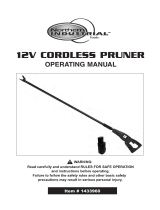
VII. Pole saw safety
1. Keep all parts of the body away from the
saw chain when the pole-mounted pruner is
operating. Before you start the pole-mounted
pruner , make sure the saw chain is not
contacting anything. A moment of inattention
while operating the pole-mounted pruner may
cause entanglement of your clothing or body
with the saw chain.
2. Always use two hands when operating the
pole ‑ ‑
‑
mounted pruner . Hold the pole-mounted
pruner with both hands to avoid loss of control.
3. T o reduce the risk of electrocution, never use
the pole-mounted pruner near any electrical
power lines. Contact with or use near power
lines may cause serious injury or electric shock
resulting in death.
4. Hold the pole-mounted pruner by insulated
gripping surfaces only , because the saw
chain may contact hidden wiring. Saw chains
contacting a ″live″ wire may make exposed
metal parts of the pole-mounted pruner ″live″
and could give the operator an electric shock.
5. W ear eye and ear protection. Further
protective equipment for hands and
slip-resistant footwear is recommended.
Adequate protective equipment will reduce the
risk of personal injury .
6. Always use head protection when operating
the pole-mounted pruner overhead. Falling
debris can result in serious personal injury .
7. Always keep proper footing and operate the
pole-mounted pruner only when standing on
xed, secure and level surface. Slippery or
unstable surfaces may cause a loss of balance
or control of the machine.
8. Do not operate a pole-mounted pruner in
a tree, on a ladder , from a rooftop, or any
unstable support. Operation of a pole-mounted
pruner in this manner may result in loss of
balance, loss of control and personal injury .
9. Keep all power cords and cables away from
cutting area. Power cords or cables may be
hidden in trees and can be accidentally cut by
the saw chain.
10. Do not use the pole-mounted pruner in bad
weather conditions, especially when there is
a risk of lightning. This decreases the risk of
being struck by lightning.
1 1. When cutting a limb that is under tension,
be alert for spring back. When the tension in
the wood bers is released, the spring loaded
limb may strike the operator and/or throw the
pole-mounted pruner out of control.
12. Use extreme caution when cutting brush and
saplings. The slender material may catch the
saw chain and be whipped toward you or pull
you off balance.
13. When carrying the pole-mounted pruner with
the machine switched off, take care not to
operate any power switch and keep the saw
chain or saw blade away from your body .
Proper carrying of the pole-mounted pruner will
reduce the likelihood of accidental contact with
the saw chain.
14. When transporting or storing the
pole-mounted pruner , always t the guide
bar cover . Proper handling of the pole-mounted
pruner will reduce the likelihood of accidental
contact with the moving saw chain.
15. When clearing jammed material, storing or
servicing the pole-mounted pruner , make
sure the switch is off and the battery pack
is removed. Unexpected actuation of the
pole-mounted pruner while clearing jammed
material or servicing may result in serious
personal injury .
16. Cut wood only . Do not use pole-mounted
pruner for purposes not intended. For
example: do not use the pole-mounted
pruner for cutting plastic, metal, masonry
or non-wood building materials. Use of the
pole-mounted pruner for operations different
than intended could result in a hazardous
situation.
17. Carry the pole saw with both hands, the pole
saw switched off and away from your body .
When transporting or storing the pole saw ,
always t the guide bar cover . Proper handling
of the pole saw will reduce the likelihood of
accidental contact with the moving saw chain.
18. Do not remove cut material or hold material
to be cut when the saw chain is moving.
Make sure the switch is off and the battery
disconnected when clearing jammed material.
Saw chain continues to move after the switch
is turned off.
19. Follow instructions for lubricating, chain
tensioning, changing the bar and chain.
Improperly tensioned or lubricated chain may
either break or increase the chance for kickback.
20. This pole saw is not intended for tree felling.
Use of the pole saw for operations different than
intended could result in serious injury to the
operator or bystanders.
21. A void kickback. Kickback may occur when the
nose or tip of the guide bar touches an object, or
when the wood closes in and pinches the saw
chain in the cut.
6




















